Giro d'Italia 2022 - Six key stages
Mount Etna looms early and trio mountaintop finishes leading to Passo Fedaia showdown

With just over 26 kilometres in total on the 2022 route, the Giro d’Italia has the lowest amount of time trialling since 1962, which at first glance makes the race one which favours the climbers. But perhaps a closer analysis suggests that it’s all-rounders, not out-and-out mountain specialists, who are going to benefit the most from the profile of the this year's race.
For one thing, the number of consecutive mountain stages is relatively minimal, with the only triptych of days in the Alps and/or Dolomites coming at the end of the second week and start of the third. As such the climbing challenges will be broken by the second rest day, and will be all the easier as a result. Secondly, there are a plethora of hilly stages in the second week and that in turn lends itself to a degree of invention from those willing to test the waters in places beyond the set-piece GC stages.
The route is still populated with mighty mountain passes, and old favourites abound, from Etna and the Blockhaus down south to the Mortirolo, Pordoi and Fedaia in the final week. So to distill the Giro’s three weeks down to just six key stages is to sell the race short, but, as ever, some days simply leap off the map.
Stage 4: Avola to Etna, 172km
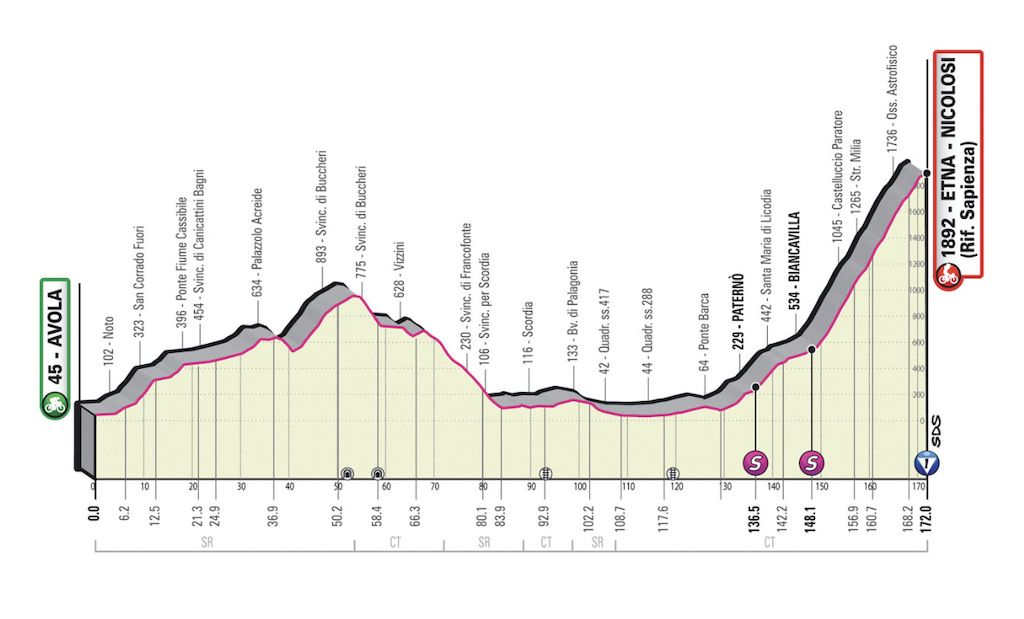
It almost feels wrong that a mountain as prestigious as Mount Etna comes so soon in the 2022 Giro d’Italia route, just as when Europe’s largest volcano featured in the 2020 and 2018 races. Yet on each occasion, and it’s testament to the difficulty of this mountain, whether it comes early or late in the Giro d’Italia, Etna is always capable of causing serious damage.
In stage 3 in 2020, on the previous ascent by the Gior, for example, there were two minutes between Wilco Kelderman, finally third on the podium, and the eventual winner Tao Geoghegan Hart, with runner-up Jai Hindley roughly a minute between each. And even before reaching Etna, Geraint Thomas had suffered a bad, freak crash when a bidon bounced up between his wheel spokes. By the summit he was over 12 minutes down.
Then in 2018, Etna was where then-teammates Simon Yates and Esteban Chaves made a serious joint attack for the line that set the scene for the GIro’s next two weeks. And in 2011, after some 10 days racing, Etna was where the Alberto Contador essentially destroyed the entire field en route to a victory he then lost almost equally dramatic fashion, as a result of a doping ban.
Never too steep (barring one short ramp at 14 per cent this year) and with no previous classified climbs on the stage route this year, Etna remains uncompromisingly punishing for multiple reasons: its length at 22 kilometres, its altitude finishing almost at 2,000 metres above sea level, and its irregularity of the gradients. Plus, there’s the fact that much of the middle part of this year’s ascent is on an unprecedented approach road so it will be harder for the peloton to judge how much energy to expend on an already hugely-taxing climb.
Get The Leadout Newsletter
The latest race content, interviews, features, reviews and expert buying guides, direct to your inbox!
But one factor never changes on Etna, and that is that, although some sections are wooded, enough of it is on a treacherously-exposed road that allows any wind to have an almost excessive influence on how the race develops. On top of which, this year (as was not the case in 2018, when the race had recently spent four days in Israel), Etna comes directly after a lengthy transfer from Hungary. And it’s the first big mountain climb of the entire race, too.
Put all those factors together and it’s almost impossible to imagine how Etna cannot produce some kind of major sort-out: not the kind that decides the race, but certainly one which will give the GC a much more defined profile than after Hungary’s very short time trial and punchy uphill finish.
As for who could make a move so early in a Giro so back-loaded with mountains in the third week, Sicily’s Vincenzo Nibali (Astana Qazaqstan) is almost obliged to put in an attack, albeit symbolic, on home soil as emblematic as Etna. But normally even without any major GC challenges (and a headwind could well stifle even the most aggressive of contenders), normally Etna is hard enough to see a real war of attrition develop, with the riders separated by small gaps at least as they approach the flatter final kilometre at the Refugio Sapienza.
Stage 9: Isernia to Blockhaus, 191km
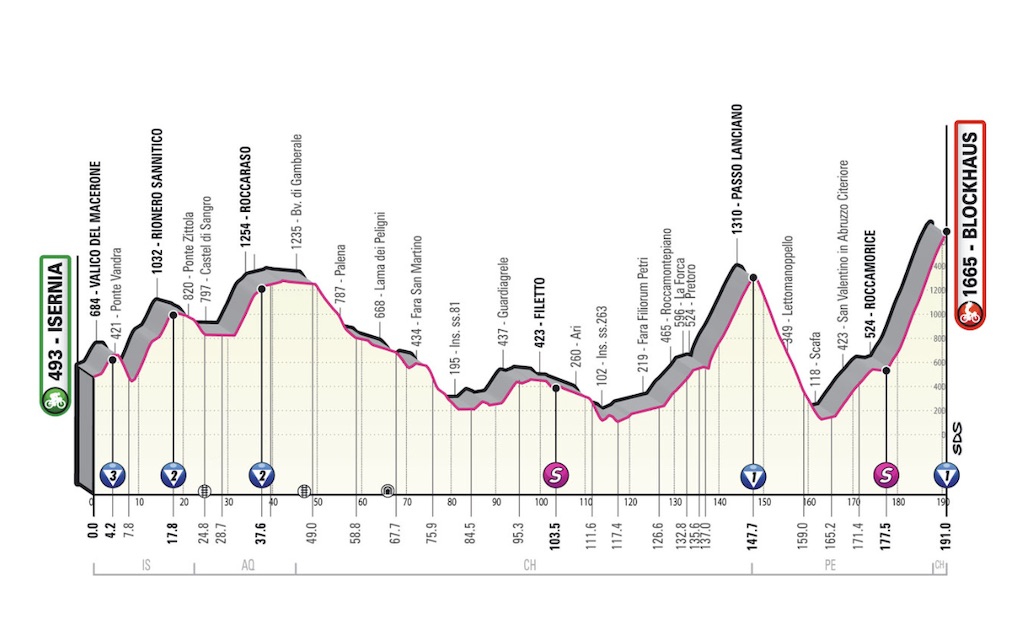
Race Director Mauro Vegni may have opted for shorter distances on this Giro – the longest stage is only 201km – but there is nothing diluted about this demanding stage through the Apennines of Abruzzo, which racks up just shy of 5,000 metres of climbing across its 191 kilometres. On leaving Isernia, the first classified ascent is the category 2 haul towards Roccaraso before an undulating run through the province of Chieti on terrain familiar from Tirreno-Adriatico.
The day’s true difficulties come in the final 50km, however, as the race reaches the Maiella National Park, with the category 1 Passo Lanciano followed by the summit finish on the Blockhaus, which returns after a five-year absence. Nairo Quintana danced into the maglia rosa on that occasion, when the Giro tackled the Blockhaus – also on stage 9 – by its longest and steepest approach for the first time. That 13.6km ascent again features in 2022, with an average gradient of 8.4 per cent and sections of 14 per cent with a shade over 5km remaining.
The Blockhaus – its Germanic name is a residue of Habsburg influence in the area – first featured in 1967, when a young Eddy Merckx was the stage winner, and its place in Giro lore was cemented five years later when the Belgian faced one of the rare crises of his imperial phase as he was distanced by José Manuel Fuente on a split stage just 48km in length.
On this occasion, with no outstanding favourite among the Giro starters, there will be no such duel between a subversive racer of the ilk of Fuente and a rider at the peak of his powers. More likely, though, a climber of the calibre of Quintana - likely to be sorely missed in this year’s Giro d’Italia - is all but bound to try to blow the race apart.
“It's the hardest of the three roads up to the Blockhaus, because it's steeper and longer than the others,” local resident Dario Cataldo told Cyclingnews in 2017. “The first part, the lead-in, is very similar to Etna in that it's regular, but the last 12 or 13 kilometres are really hard. Up there, being on the wheels won't count for anything and having a team around you won't count for much. The legs will make the difference.”
The Giro’s first big climb, the Etna, will be a very reliable indicator of who cannot win the race, but there will be ample time for riders to set the record straight, as Geoghegan Hart did in 2020. The Blockhaus will have a different role. As was the case in 2017, when Quintana scored a notable success and even claimed the lead, but overall winner Tom Dumoulin limited his losses, we can expect the Blockhaus to act as the first real indicator of how the Giro could play out in the mountain stages among the contenders. And time losses there will be much harder to recover.
Stage 15: Rivarolo Canavese to Cogne, 177km
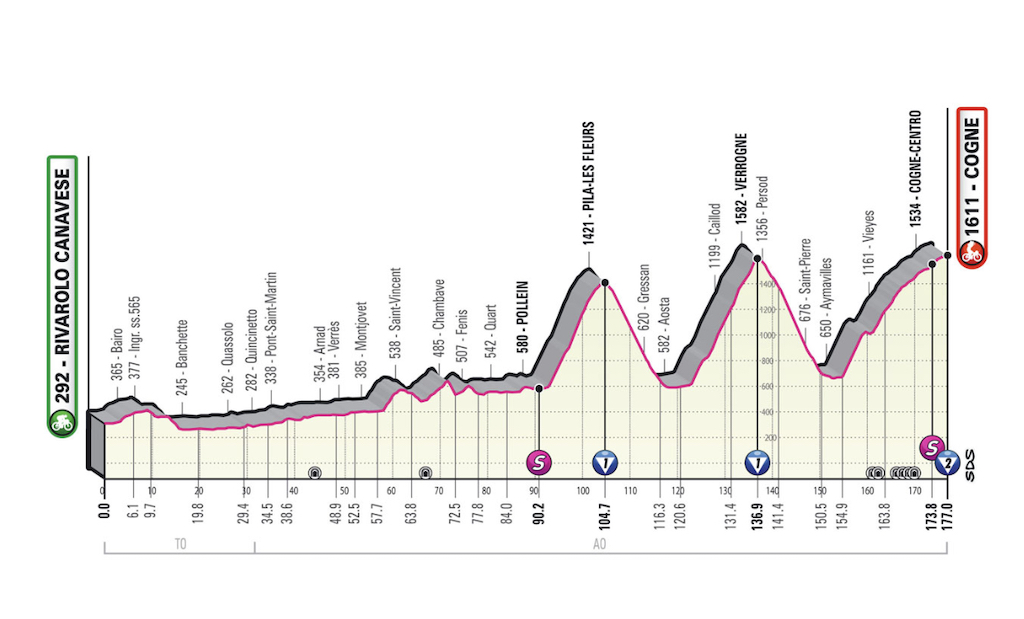
The climbs in this part of the Alps tend to be long and steady rather than brutally steep, but with 46 kilometres of climbing in the last 80 on this opening Alpine stage, you could be forgiven for arguing it makes little difference.
Coming at the end of a second week that has alternated between hilly and flat stages, the trio of grinding ascents in the second half of the day are not likely to see major all-out attacks - the third week has enough opportunities for that.
But this is perfect terrain for a team packed with top mountain specialists and all-rounders - Ineos Grenadiers, Bora-Hansgrohe, UAE Team Emirates, Jumbo-Visma and Bahrain Victorious all spring to mind - to lay down the kind of pace that will winnow out the peloton to a dozen riders at most by the end of the day. Stage 14 will likely be a test of team work, then rather than individual showmanship, but the effect overall could be devastating.
That effect could be all the more telling after the preceding Turin stage, which is far harder than it looks on paper. Indeed, it would be tempting to list stage 14, with an intriguing circuit over the Maddelena and Superga that packs some 3,470 metres of climbing into just 153km, among the six key stages of this Giro.
Too short for an early break to ease clear and too unrelenting for any one team to control affairs, this nervous stage has the potential to make a significant impact on the GC picture. That said, the following day’s foray into the Alps looks certain to do so.
As for stage 14, it’s a stage of two distinct parts, starting with a gentle run along the Dora Baltea river as the race heads out of Piedmont and towards Valle d’Aosta. The climbing begins shortly after the midpoint, with the category 1 ascent towards Pila – which featured as a summit finish in 1987 – though only as far as Les Fleurs, at an altitude of 1,421 metres.
Another long, category 1 climb follows shortly afterwards, as the gruppo tackles the almost 20km haul up to Verrogne, which was included on the pivotal stage to Courmayeur in 2019.
The final ascent to Cogne is itself some 22.4km in length, and though the average gradient is a mild 4.3 per cent, there are several demanding stretches in the opening third of the climb from Aymavilles, and the road still drags inexorably upwards in the Gran Paradiso National Park in the final 10km. Any contenders carrying the weight of a combative second week in their legs could endure a setback here.
Stage 16: Salo to Aprica, 202km
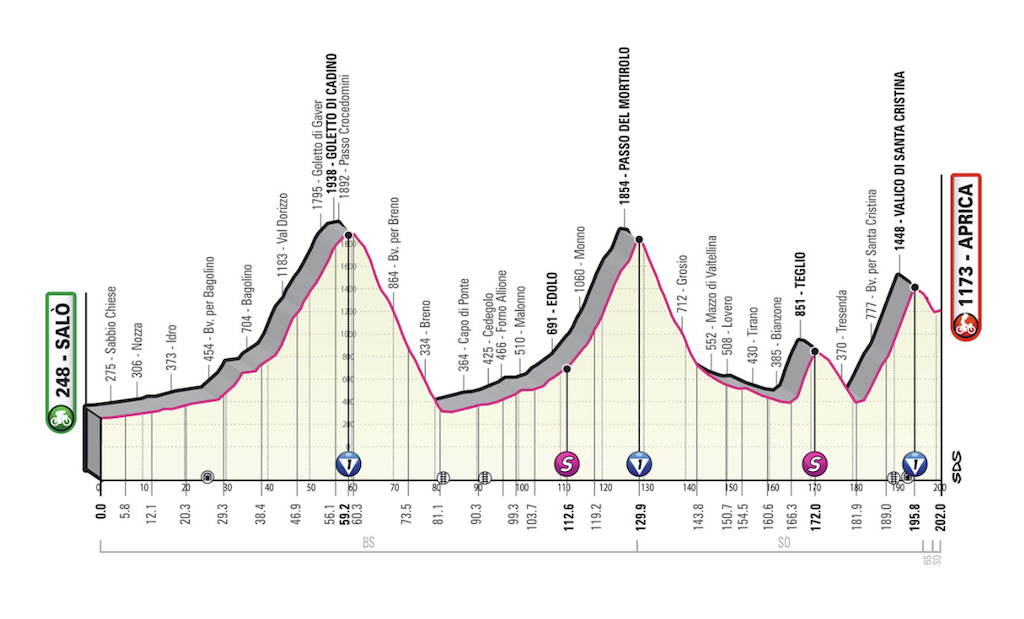
As ever, the principal difficulties of this Giro are positioned in the last week of the race, and there is a typically brutal return to business after the third and final rest day. The 202km leg in Valtellina also serves to promote the local Sforzato wine, and perhaps it’s only fitting that a day with 5,440 metres of climbing should be accompanied by a glass of a beverage that translates literally as ‘strained.’
Arguably the most difficult single day in the mountains of the entire Giro d’Italia is stage 16, and the chances of this being won by anything other than an out-and-out climber are minimal. Assuming they are in top form, riders like Simon Yates (BikeExchange-Jayco), Hugh Carthy (EF Education-EasyPost) and Miguel Ángel López (Astana Qazaqstan) will be utterly in their element. Everybody else will be on the defensive, particularly given the day’s final obstacle, the category 1 Valico di Santa Cristina. That climb is forever associated with legendary climber Marco Pantani’s defenestration of Grand Tour’s patron of the era and Miguel Indurain in the 1994 Giro. (The Santa Cristina last featured, incidentally, on the day Pantani was expelled from the 1999 Giro for a high haematocrit, with Ivan Gotti inheriting the maglia rosa in Aprica after escaping with Roberto Heras and Gilberto Simoni. But that’s another story, or a rather a very different side of the same one.)
The stage gets underway on the shore of Lake Garda at Salò before following the Val Sabbia as far as the day’s first ascent, the category 1 Goletto di Cadino, which makes its third appearance on the Giro after back-to-back airings in the 1990s. Gianni Bugno led over the top in 1997, while Niklas Axelsson was first up here 12 months later, though the day is best remembered for Pantani’s duel with Pavel Tonkov on the final ascent of Montecampione.
Next on the agenda is the Mortirolo, and although it’s climbed on this occasion via its ‘easier’ approach from Edolo, that’s all relative in this particularly-jagged corner of Lombardy. The climb via Edolo caused consternation when it first introduced the Mortirolo as a concept on the 1990 Giro, with Leonardo Sierra was first to the top en route to stage victory, and it will provoke ample difficulties here too. It may not have the gaudy statistics and fearsome mystique of the approach from Mazzo di Valtellina, but the category 1 ascent is 12.6km at an average gradient of 7.6 per cent, with pitches of 16 per cent approaching the summit.
After a treacherous descent, the road climbs again towards the intermediate sprint at Teglio before the gruppo tackles the day’s last challenge, the first-category Valico di Santa Cristina.
The Santa Cristina is a most severe climb, which cruelly seems only to grow more difficult as it draws on. The ascent is 13.5km in length with an average gradient of 8 per cent, but the slopes rarely drop below double-digits in the final 5km. The summit is just over 6km from the finish in Aprica, and the time gaps could be hefty.
Stage 17: Ponte di Legno to Lavarone, 168km
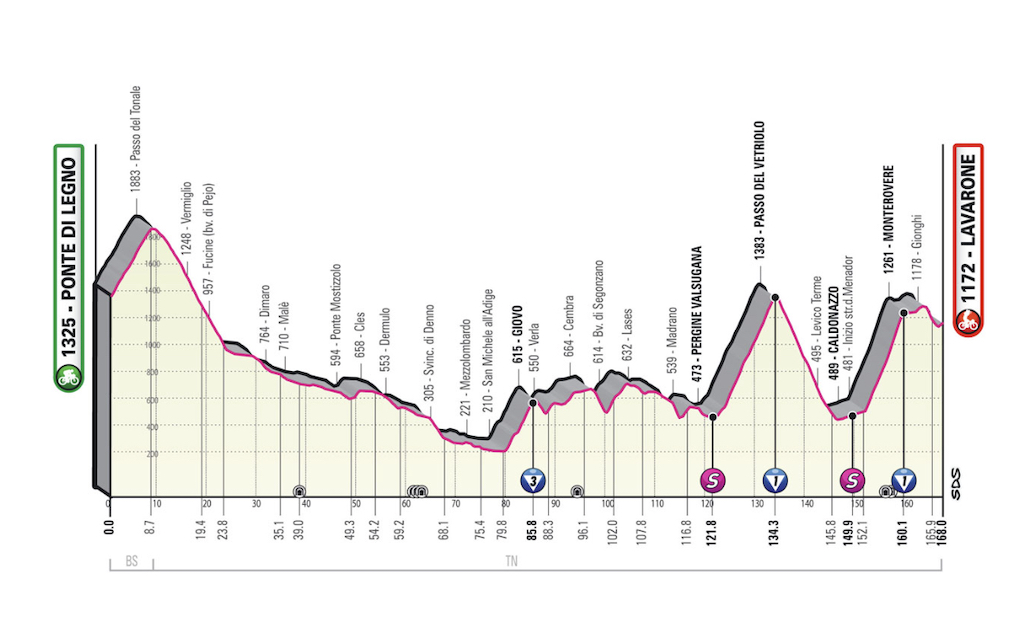
The protracted presentation of the 2022 Giro meant that the mountain stages were rather divorced of context when they were first unveiled, but now that the hazy picture of this year’s race has finally sharpened into focus, the significance of stages 16 and 17 has become clear. Remarkably, these are the only back-to-back high mountain stages in the entire race, even if the uphill finish to stage 19 is hardly a gentle preamble to the Dolomite tappone that follows.
Coming immediately after the tough leg over the Mortirolo and Santa Cristina, there are sure to be weary limbs and fraying minds in the pink jersey group, and even if the terrain is perhaps not quite as daunting on the road to Lavarone, the potential for big changes in the GC is probably greater, as cumulated fatigue begins to exact a toll.
If the outcome of stage 15 is likely to be mostly about climbing team work and stage 16 is almost certain to see individual fireworks on the mountain slopes, stage 17 should be about a combination of both. As the third mountain stage in a row, this is the point when any GC leader will be at their most vulnerable and with Verona only five days away, the collective sense that the race is approaching a last-chance saloon and there is little to lose will be beginning to kick in.
At a distance, the most likely scenario is for a large break of non GC favourites who have taken a back seat in the previous two days to chance their arm and go for a stage win. But that will also be the best opportunity for GC challengers to test the leader’s overall climbing strength. Combine the two and you’re almost certain to be guaranteed fireworks.
The road climbs immediately after the start in Ponte di Legno, taking in the steady haul up the Passo del Tonale. The 8.8km ascent is not classified, but few will appreciate such a sharp start to the day’s proceedings, though the long, long drop towards Moser country in Palù di Giovo should mitigate that early difficulty.
The undulating run through the Valle di Mocheni serves as a precursor to the day’s main obstacles, the category 1 ascents of the Passo del Vetriolo and the Salita del Menador. The Vetriolo has featured before, albeit from the opposite side, with Andy Hampsten winning a mountain time trial in 1988 and Julio Jimenez twice leading over the top in the 1960s. This time out, the Giro climbs the Vetriolo from Pergine Valsugana before dropping to Levico Terme.
The great novelty, however, is the short (6.2km) but sharp category 1 ascent of the Salita del Menador, a tightly packed clutch of hairpins and tunnels carved into the rock face as a supply line by the Austro-Hungarian Kaiserjäger regiment during World War I. That sinuous road was subject to significant widening over the past year, prompting speculation that the Giro might be on the way. Or, as local newspaper L’Adige put it when the route was unveiled: “That explains the road works.”
The summit of the Salita del Menador at Monte Rovere comes eight, rippling kilometres from the finish at Lavarone, but it’s difficult to envisage anyone dropped on the Kaiserjägerstraße summoning up the strength to force their way back on before the finish on a day of attrition such as this.
Stage 20 Belluno to Passo Fedaia, 168 km
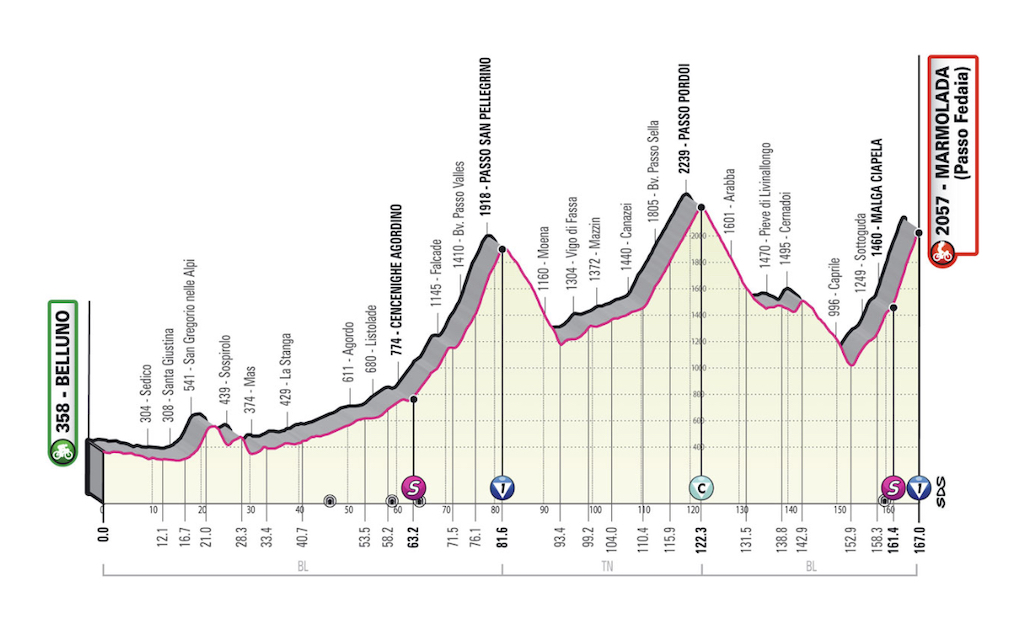
The obvious conclusion about a mammoth mountain stage on the second to last day of a Grand Tour, finishing with a time trial 24 hours later, is that for the climbers, this is a question of now or never. The reality is, by this point in a Giro d’Italia which all but began, let’s not forget, with an ascent as daunting as the Mount Etna, the most likely winner is whoever still can muster enough energy to put in an attack, no matter their speciality.
As such (and particularly with that sting-in-the-tail TT left to come), whoever is in the lead will almost certainly want to play a defensive game. The previous two, relatively easier stages, will have provided something of a breathing space. But the Giro’s last day in the mountains is famous for throwing up surprises and in a race with none of the most successful of GC stars taking part, nobody will be taking anything for granted.
The penultimate stage is also, incidentally, the first time the race climbs above 2,000 metres as it takes in the Passo Pordoi and the Fedaia. Given how the climate crisis seems to have made racing at high altitudes in mid-May ever more hazardous over the past decade, it is perhaps hardly surprising that Race Director Mauro Vegni waited until the tail end of the month to cross that particular threshold on this Giro.
The Pordoi and Fedaia were supposed to feature in 2021 as part of a 212km tappone with some 5,700m of climbing, but foul weather saw the stage abridged, though not exactly diminished, as Egan Bernal soloed clear on the Passo Giau anyway to put himself in an insurmountable position atop the overall standings.
This time out, the planned Dolomite extravaganza is a little shorter at 165km, though hardly much easier, with some 4,490 metres of climbing on the programme. The stage has a relatively gentle opening stanza in the Piave valley, but the road becomes altogether more arduous with 100km remaining as the seemingly interminable Passo San Pellegrino rears into view. The category 1 ascent drags upwards to an altitude of 1,910m, and its stiffest, 15 per cent slopes section come inside the final 10 kilometres.
The drop to Moena and the rather false flat towards Canazei are followed by the Cima Coppi of the 2022 Giro, the mighty Passo Pordoi, which climbs for 11.8km at an average gradient of 6.8 per cent. The 2,239m-high Pordoi has been a fixture on the Giro since 1940, with Fausto Coppi first to the top on no fewer than five occasions in those early years, and the history of the place both inspires and intimidates.
The same can be said of the Passo Fedaia, which – weather permitting, of course – returns to the route for the first time since 2011. The ascent towards the rocky precipice of the Marmolada made its first appearance in 1975, but it has only been used as a summit finish on one previous occasion, when Emanuele Sella – soon to test positive for CERA – claimed part of his hat-trick of mountain stage wins here.
The Fedaia is 14km at an average gradient of 7.6 per cent, but, as ever, the numbers only hint at the true nature of this beast. Above all, the Fedaia is haunting because of the geography of the place and configuration of the road, most notably the seemingly-incessant straight at Malga Ciapela, which starts with a little under 6km to go and where the gradient clicks into double digits and then dials all the way up to 18 per cent, with little to no sign of relief on the horizon. It’s something akin to cycling’s Strait of Magellan. Cruelly, this Giro’s most turbulent waters come very close to the shore.

Barry Ryan was Head of Features at Cyclingnews. He has covered professional cycling since 2010, reporting from the Tour de France, Giro d’Italia and events from Argentina to Japan. His writing has appeared in The Independent, Procycling and Cycling Plus. He is the author of The Ascent: Sean Kelly, Stephen Roche and the Rise of Irish Cycling’s Golden Generation, published by Gill Books.